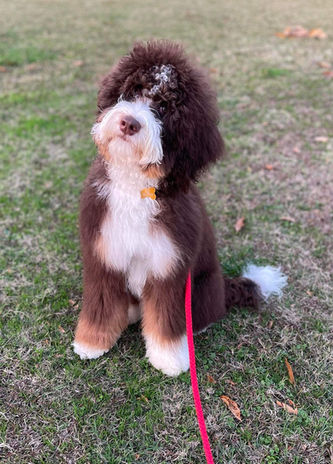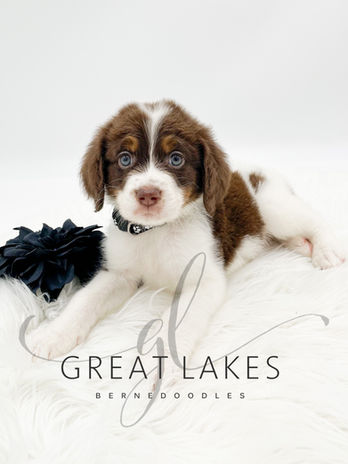Reservations and Colors

If you are interested in one of our Bernedoodles, please fill out the PUPPY APPLICATION FORM If your adoption form is approved, I will contact you and request a $500 NON-REFUNDABLE reservation fee to reserve a puppy. If you decline a puppy when it becomes available, you may lose your reservation fee unless you roll it toward a future litter. You will lose your reservation fee if you cancel at the last minute and I have already booked and paid for flights. Great Lakes Bernedoodles has the right of refusal on the purchase of a puppy at any time.
If a puppy is available at the time you place the reservation fee you will only have to wait a maximum 8-10 weeks. If you leave a reservation fee before breeding has taken place or just after, wait time can be up to one year depending on the length of my current list. Leaving a reservation fee before breeding has taken place or just after will ensure you are able to get a puppy out of the closer upcoming litters. If you would like to purchase a puppy please call, email to make reservation payment!
Black Tri Color
Tri-color is a fascinating is visually striking color known for its distinctive coat patterns that combine three different colors, typically black, white, and tan. The tri-color pattern often showcases a rich blend of the three colors, with black being the dominant hue, interspersed with white patches and tan highlights around the face, legs, and chest.
In most tri-color dogs, black is the dominant hue. This deep, rich color serves as the base, providing a striking contrast to the lighter shades present in the coat. The black areas often cover a significant portion of the body, lending a bold and dramatic appearance to the dog.
White patches intersperse the dominant black, adding brightness and visual interest. These patches can vary in size and placement, often appearing on the chest, belly, and face. The white segments offer a pleasing contrast that enhances the overall beauty of the tri-color pattern.
The tan highlights are the final touch in the tri-color ensemble, often found around the face, legs, and chest. This warm hue adds depth and dimension, accentuating the dog's features and providing a harmonious balance between the black and white tones.
Chocolate Tri Color
The chocolate tri-color dog is a captivating and unique variation of canine fur patterns that exudes charm and elegance. This coat coloration typically features a rich, chocolate brown base complemented by striking patches of white and tan, creating a delightful tri-color ensemble.
The chocolate tri-color coat is distinguished by its harmonious blend of three colors: Chocolate brown base is the primary color provides a warm, luxurious foundation that is both soothing and visually appealing. White patches are often found on the chest, paws, or face, adding contrast and brightness to the overall appearance. Tan accents usually appearing on the eyebrows, cheeks, or legs, these highlights add depth and complexity to the coat's design.
Phantom and Phantom Abstract
Phantom color in dogs is a fascinating genetic trait that results in a distinctive pattern of markings on a dog's coat. Phantom is very similar to what we refer to as tri color but without white markings or with more minimal white markings. This pattern is characterized by a base coat color, often black or dark brown, with lighter markings that usually appear above the eyes, on the muzzle, chest, and legs. Phantom abstract will have white markings similar to a tri, usually on the chest, chin and maybe a little on the tips of the toes.
Blue Merle Tri Color
In the captivating realm of canine coat genetics, the "blue merle tri color" is a striking and sought-after pattern. This term encompasses three main components: the blue base color, the merle pattern, and the tri-color combination.
In dog coat terminology, "blue" refers to a diluted form of black. This color typically appears as a soft grayish hue and can vary in shade, from light silver to a deeper charcoal. The blue coloration is the result of a genetic dilution of the black pigment.
Merle is a specific pattern that creates a stunning effect on a dog's coat. It is characterized by patches of diluted color mixed with patches of the base color, resulting in a dappled or mottled appearance. The merle gene can modify the base color, producing a dynamic look that is both eye-catching and complex. This pattern adds depth to the dog’s appearance, enhancing the visual interest of the coat.
The term "tri color" refers to the presence of three distinct colors within a dog's coat. This typically includes a primary base color, complemented by two additional colors that manifest as markings. In traditional tri-color patterns, these colors often include black, white, and a shade of tan or brown. However, the introduction of the merle gene allows for a more varied and unique combination of colors that may deviate from the standard tri-color.
When combined, a "blue merle tri color" dog showcases a predominantly blue coat with a beautiful marbled effect introduced by the merle pattern.
Chocolate Merle Tri Color
The term "chocolate merle tri color" is often used in the context of dog coat colors, particularly in breeds that carry the merle gene.
In the dog world, the term chocolate refers to a rich brown color. This color can vary in shade from a light milk chocolate to a dark, almost black chocolate. It is a result of the dilution of the black pigment.
Merle is a pattern in a dog's coat, not a color. It is characterized by patches of diluted color mixed with patches of full color, creating a mottled or dappled effect.
Tri color refers to the presence of three distinct colors on a dog's coat. Commonly, this includes a base color with secondary and tertiary colors typically appearing as markings. In many breeds, the traditional tri-color pattern includes black, white, and tan or brown, but with a merle gene, these colors can vary.
When you combine all these elements, a "chocolate merle tri color" dog would have a predominantly brown (chocolate) coat, with merle patterning that introduces a marbled effect, and three distinct colors visible on its coat. This combination is visually striking and relatively rare, making it highly sought after among dog enthusiasts.
Sable Merle
The sable merle is a fascinating and unique coat color pattern. Combining the sable and merle patterns, this coloration can lead to a striking and beautiful appearance.
The sable coat pattern is characterized by individual hairs that have multiple colors along their length. Typically, the base of the hair is a lighter color, often tan or gold, which gradually darkens to black or a darker shade towards the tip. This gives the dog a dynamic and multi-tonal appearance.
The merle pattern, on the other hand, is a result of a specific gene that creates patches of diluted pigment in the dog's coat, leading to a mottled or dappled appearance. This gene can also affect eye color, often resulting in striking blue or mismatched eyes.
When combined, the sable merle pattern results in a dog that has the characteristic sable multicolored hairs interspersed with the merle's diluted patches. This can create a subtle or more pronounced mottled effect depending on the individual dog's genetics. The interplay between the sable and merle genes can vary widely, making each sable merle dog unique.
Sable
The sable coat color in dogs is a captivating and unique trait that adds an element of elegance and diversity to a dog's appearance. This coat pattern is characterized by a combination of lighter and darker hairs, where each individual hair is tipped with a darker color, often black. The sable coloring creates a dynamic, gradient effect that can vary widely in intensity and distribution across different breeds. The sable coat can range from a subtle, soft blend of colors to a striking, bold contrast.
Red Bi Color
Red bi-color dogs are a striking and beautiful variation of bi-color breeds, characterized by a combination of deep, rich red hues with contrasting white markings. The red can range from a warm, coppery shade to a more intense mahogany, while the white markings typically appear on the chest, paws, face, and sometimes along the belly and tail. The balance of these colors creates a bold yet elegant appearance, making red bi-color dogs stand out with their unique and eye-catching coats.
Parti Color
Parti-color dogs are those with coats that feature large, distinct patches of two or more colors. The term "parti-color" comes from the word "parti," meaning "part," referring to the way the different colors are distributed across the dog’s fur. Commonly, these dogs have a base color—such as white, black, or brown—interspersed with patches of another color like tan, gray, or even a combination of multiple hues. Each parti-color dog is like a living work of art, with its own distinctive mix of colors and markings.






























































































